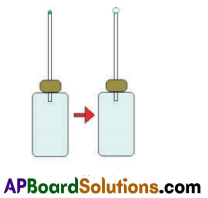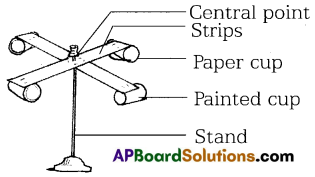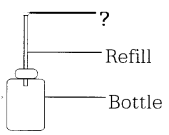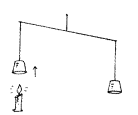These TS 7th Class Science Important Questions 8th Lesson Air, Winds and Cyclones will help the students to improve their time and approach.
TS 7th Class Science Important Questions 8th Lesson Air, Winds and Cyclones
Question 1.
Write about uneven heating between the equator and the poles.
Answer:
- The region close to the equator gets more heat from the sun.
- This is because of the direction of the sunlight being straighter and closer to the equator.
- The air in these regions gets warmer.
- The warm air rises, and the cooler air from the regions in the 0-30° latitude belt on either side of the equator moves in.
- This movement of air sets forth winds that move over the earth.
![]()
Question 2.
Write about uneven heating of land and water in different seasons.
Answer:
- In summer, near the equator the land heats up faster and during the day, the temperature of the land is higher than the water in the ocean.
- The air over the land gets heated and rises. This causes the winds to flow from the oceans towards the land.
- These are monsoon winds.
- This is usual during the months June to September.
- The direction of the wind flow gets usually reversed in the months from December to early March.
- The wind flows from the land to ocean as the sea cools more slowly.
Question 3.
What are cyclones ? Give some examples.
Answer:
Cyclones are a form of violent storms on earth.
Eg: phoons, hurricanes, tornadoes etc.
Question 4.
What are the factors contributing cyclones?
Answer:
Wind speed, wind direction, temperature and humidity contribute to the development of cyclones.
![]()
Question 5.
Ram wanted to know about air and its pressure. What questions may arise in his mind? Fame some of them?
Answer:
- How air influences the Earth?
- What are the uses of air – pressure?
- In which conditions air exerts more pressure?
- Can we find air and its pressure all the day?
Question 6.
What would be reason behind upward movement of smoke released from the lit-up incense stick?
Answer:
- When incense sticks are burnt, the air in the surroundings warms and rises up.
- Also it is known that on heating the air expands and occupies more space.
- When something occupies more spice, it becomes less dense.
- The warm air is therefore less dense than cold air. Thus smoke and hot air go up.
Question 7.
How can you show hot air is lighter than cold air?
Answer:
Aim : To prove that hot air is lighter than cold air.
Apparatus : Two paper cups, candle, thread and broom stick.
Procedure :
- The two paper cups are taken.
- Those two cups are hanged on the two ends of the broom stick.
- A piece of thread is tied in the middle of the stick.
- The stick is held up by the thread like weighing balance
- Then the burning candle is kept below one of the cups as shown in the figure. 1

Observation : The balance of the cups is disturbed. The cup which is without candle shows more weighing than other one which is with burning candle below it.
Reason : The air in one of the cups gets heated. That hot air enters the cup. When the air becomes hot, its density and pressure decrease. As a result, it enables the affected cup to weigh lesser than the other cup.
![]()
Question 8.
By observing the above pictures, what would you predict?

Answer:
When the bottle is immersing in the bucket, air bubbles will come out of the bottle till it fills with water. It is evident that a glass or bottle that we think empty is actually full of air. Any bottle, glass or any container that appears empty is actually full of air. Nothing can be added to it unless the air inside is removed.
Question 9.
By observing the above pictures, write the steps needed for using those droppers.

Answer:
Step – 1: First we have to press by applying pressure on rubber bulb (head) of the filler.
Step – 2: While pressing the rubber bulb, the filler is to be kept in the fluid
Step – 3: When it. is immersed in the fluid, we have to reduce the pressure of the rubber bulb.
Then, fluid enters the filler easily.
Question 10.
Write the occasion you see regarding influence of air and its pressure.
Answer:
- Sending hot balloons into the sky.
- Meteorological department sends balloons to forecast the weather.
- Burning sticks release fire up into the atmosphere.
- Incense sticks release smoke up into the air intormation
![]()
Question 11.
A water drop on the upper end of the refill is shown in the figure. Hands are rubbed to make warmth. Then the bottle is held into the hands for sometime.
What happens to the water drop ? How does it behave?

Answer:
When bottle is held up in both the warm hands, the heat touches the bottle and air inside the bottle gets warmth. That warmth air goes up into the refill and touches the water drop. Then water drop behaves increasing its size.
Question 12.
Draw a neat labelled diagram of anemometer that you prepared in the school.
Answer:

Question 13.
What are Do’s and Don’ts during cyclones?
Answer:
Cyclones — Do’s and Don’ts:
- We should not ignore the warnings issued by the meteorological department through TV radio or news papers. Pass on the information to others and ignore rumors.
- When a cyclone alert is announced in your area, follow the radio bulletins.
- We should make necessary arrangements to shift essential household goods, domestic animals and vehicles etc., to safer places.
- Switch off electrical mains in your house.
- Keep ready the phone numbers of all emergency services like police, fire brigade and medical centres.
- Keep essential medicines, food material, drinking water for yourself and your family.
![]()
Question 14.
What are the post cyclone measures?
Answer:
Post cyclone measures:
If you are staying in a cyclone hit area —
- Strictly avoid any loose and dangling wires.
- Do not drink water that could be contaminated. Always store drinking water for emergencies.
- Do not go out for the sake of fun.
- Cooperate and help your neighbours and friends.
Question 15.
How has advanced technology helped to detect cyclones?
Answer:
- Advanced technology has helped and these days. we are better protected.
- In the early part of last century, coastal residents may have less than a day to prepare or evacuate their homes from an oncoming cyclone.
- The world today is very different.
- Thanks to satellites and radars, a cyclone alert or cyclone watch is issued 48 hours in advance of any expected storm and a cyclone warning is issued 24 hours in advance.
- The message is broadcasted every hour or half an hour when a cyclone is near the coast.
- Information about cyclones will be given by the Indian Meteorological Department (IMD).
Choose the correct answer:
I. ConceptuaI Understanding
Question 1.
In India, cyclones usually occur in the months of …………. ( )
A) May – June
B) October – November
C) January – March
D) A and B
Answer:
D) A and B
Question 2.
One of the following doesn’t depend on air pressure. ( )
A) Syringe
B) Air pump
C) Steering
D) Balloon
Answer:
C) Steering
Question 3.
Air exerts pressure. ( )
A) Upward
B) Downward
C) Sideward
D) All
Answer:
D) All
![]()
Question 4.
One of the following plays an important role in the formation of storms? ( )
A) Wind speed
B) Heat
C) Clouds
D) Rain
Answer:
A) Wind speed
Question 5.
Uneven heating on the earth causes ……..movements. ( )
A) wind
B) water
C) gas
D) soil
Answer:
A) wind
Question 6.
Air around us exerts ( )
A) fire
B) dampness
C) pressure
D) free
Answer:
C) pressure
Question 7.
At might the land cools than the sea. ( )
A) slower
B) faster
C) lower
D) A and B
Answer:
B) faster
![]()
Question 8.
In India, more cyclones tend to occur on the side. ( )
A) western
B) southern
C) northern
D) eastern
Answer:
D) eastern
Question 9.
The quantity of water vapour in the air is called ( )
A) rain fall
B) temperature
C) humidity
D) climate
Answer:
C) humidity
Question 10.
Air moves from a region of.. pressure to a region of…pressure. ( )
A) high – high
B) low – low
C) high- low
D) low – high
Answer:
C) high- low
II. Asking Questions and Making Hypothesis
Question 11.
Which of the following is a correct hypothesis to state that it is going to rain? ( )
A) Blowing of speed wind
B) Forming of black clouds
C) Scorching sun
D) Dry breeze
Answer:
A) Blowing of speed wind
![]()
Question 12.
Find the odd one out. ( )
A) Cyclones
B) Tsunamis
C) Hurricanes
D) Priaries
Answer:
D) Priaries
III. Experimentation and Field lnvestigation
Question 13.
Air expands on ( )
A) heating
B) cooling
C) stretching
D) contracting
Answer:
A) heating
Question 14.
The instrument that measures wind speed is ( )
A) anemometer
B) spherometer
C) speedometer
D) barometer
Answer:
A) anemometer
Question 15.
Injection syringe works with the help of ……..
A) air – movement
B) water – pressure
C) air – pressure
D) air – life
Answer:
C) air – pressure
![]()
Question 16.
When you press the rubber bulb ………..
A) the pressure of air increases
B) the pressure of air decreases
C) the pressure remains same
D) the pressure becomes fast
Answer:
B) the pressure of air decreases
IV. Information Skills and Projects
Question 17.
Meteorologists measure the wind speed using ( )
A) thermometer
B) anemometer
C) rain guage
D) hydrometer
Answer:
B) anemometer
Question 18.
Humidity is measured by using an instrument called ( )
A) manometer
B) thermometer
C) hydrometer
D) hygrometer
Answer:
D) hygrometer
Question 19.
In which ocean more cyclones occur? ( )
A) Bay of Bengal
B) Indian ocean
C) Arabian sea
D) Pacific ocean
Answer:
A) Bay of Bengal
![]()
Question 20.
In 2008, Thunami occurrence in ……. ( )
A) Lakshadweep
B) Green land
C) Andaman and Nicobar Islands
D) Srilanka
Answer:
C) Andaman and Nicobar Islands
V. Communication through Drawing and Model Making
Question 21.
Find out the part in the given diagram. ( )

A) air bubble
B) water drop
C) gas
D) B and C
Answer:
B) water drop
Question 22.
Where does pressure exert in the given picture?

A) on the surface of water
B) on the fingers
C) on the bowl
D) on the tube
Answer:
A) on the surface of water
![]()
Question 23.
Given picture shows. ( )

A) Air expands on cooling
B) Air contracts on cooling
C) Air expands on heating
D) Air contracts on cooling
Answer:
C) Air expands on heating
VI. Appreciation and Aesthetic Sense and Values
Question 24.
The time period of reverse flow of monsoon ( )
A) June – July
B) July – August
C) October – November
D) March – April
Answer:
C) October – November
![]()
Question 25.
……….. are a form of violent storms on Earth. ( )
A) Tsunamis
B) Cyclones
C) Winds
D) None
Answer:
B) Cyclones